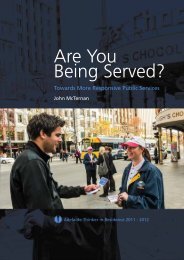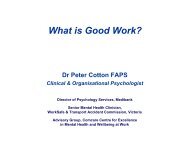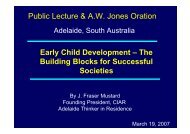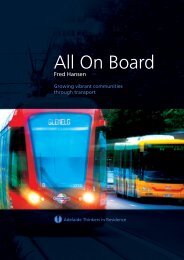Download pdf of Fred Hansen's report - Adelaide Thinkers in ...
Download pdf of Fred Hansen's report - Adelaide Thinkers in ...
Download pdf of Fred Hansen's report - Adelaide Thinkers in ...
- No tags were found...
Create successful ePaper yourself
Turn your PDF publications into a flip-book with our unique Google optimized e-Paper software.
As is <strong>of</strong>ten the case with community-based organisations, <strong>in</strong>dividual residents are<strong>in</strong>terested <strong>in</strong> some issues affect<strong>in</strong>g their neighbourhood while other residents careabout other issues. Through their <strong>in</strong>dividually elected Neighbourhood Officers theseorganisations develop an approach to both keep<strong>in</strong>g their community members <strong>in</strong>volved(the required government notification to all residents near a proposed action is the firststep) and <strong>in</strong>volv<strong>in</strong>g those <strong>in</strong>terested residents <strong>in</strong> develop<strong>in</strong>g the formal position theassociation should take deal<strong>in</strong>g with issues.Neighbourhood associations have been most effective when they make constructiverecommendations, not just oppose anyth<strong>in</strong>g that is put forward. As a result <strong>of</strong> be<strong>in</strong>gconstructive they are listened to even when they f<strong>in</strong>d it necessary to deliver an ‘underno circumstances should this be allowed to move forward’ recommendation.Developers work<strong>in</strong>g with communityThis is the formal structure. What is at least as important is how these neighbourhoodassociations have evolved <strong>in</strong>formally <strong>in</strong> their relation to government actions. Firstand foremost, private proposers have learned that they cannot take their proposal togovernment and expect government to overrule the neighbourhood. More <strong>of</strong>ten thannot the govern<strong>in</strong>g body, be that a state agency or local council, tells the proposer thatthey must work with the neighbourhood association to solve the areas <strong>of</strong> conflict. Overtime, savvy proposers have learned to work with the neighbourhood association whentheir proposal is at the earliest stages <strong>of</strong> development. This has allowed proposals to bemodified <strong>in</strong> a way that meets the <strong>in</strong>terests <strong>of</strong> both the neighbourhood and the proposer.Not all proposals are for construction <strong>of</strong> someth<strong>in</strong>g. Many times they are for an activity,such as the location <strong>of</strong> a mental health facility or the open<strong>in</strong>g <strong>of</strong> a sports bar. In thesecases government will <strong>of</strong>ten require the neighbourhood associations and the proposerto enter <strong>in</strong>to a good neighbour agreement – one that is negotiated between the parties.Such agreements typically spell out <strong>in</strong> great detail what is expected <strong>of</strong> the proposer andwhat happens if problems develop.This formal structure <strong>of</strong> neighbourhood associations has not elim<strong>in</strong>ated conflict <strong>in</strong>Portland. However, it has allowed for formal and <strong>in</strong>formal processes to be developedto work through and resolve many <strong>of</strong> the conflicts – <strong>in</strong> short, to f<strong>in</strong>d common groundrather than battle ground. It has enabled community members to become <strong>in</strong>volved <strong>in</strong> thedecisions that affect them and to have very mean<strong>in</strong>gful ways to <strong>in</strong>fluence those decisions.It has also allowed government a formal mechanism to engage the community <strong>in</strong> itswork. Over time, government has learned the benefit <strong>of</strong> engag<strong>in</strong>g its community throughthese structures at earlier and earlier po<strong>in</strong>ts <strong>in</strong> the consideration <strong>of</strong> an issue. All this hasled to a community more <strong>in</strong>volved <strong>in</strong> th<strong>in</strong>gs affect<strong>in</strong>g them. And from the standpo<strong>in</strong>t <strong>of</strong>government action, government has been able to produce a better project or programthan it would have had the neighbourhood not been <strong>in</strong>volved.When conflicts are not resolvable is the time to have elected <strong>of</strong>ficials step <strong>in</strong> and makedecisions to the benefit <strong>of</strong> the whole community.Us<strong>in</strong>g communication toolsIn addition, as our means <strong>of</strong> communicat<strong>in</strong>g and <strong>in</strong>teract<strong>in</strong>g have fundamentallychanged through the use <strong>of</strong> the <strong>in</strong>ternet and social media, government must embracethese changes and develop and use these alternative tools to be effective at communityengagement.As mentioned earlier, the Portland model is just one approach. Other cities and othercountries have adopted other models. Whatever is adopted, it must conta<strong>in</strong> at least threekey pr<strong>in</strong>ciples.• It is never too early to <strong>in</strong>volve the community <strong>in</strong> issues directly affect<strong>in</strong>gtheir neighbourhoods (or as we like to say about vot<strong>in</strong>g <strong>in</strong> Chicago, ‘earlyand <strong>of</strong>ten’).• When structures exist at the neighbourhood level it is the responsibility<strong>of</strong> the proposer <strong>of</strong> a development, program or activity to engage thoseneighbourhood structures to work through possible concerns. Electedgovern<strong>in</strong>g bodies must be discipl<strong>in</strong>ed and not step <strong>in</strong> at early stages,putt<strong>in</strong>g themselves <strong>in</strong> the position <strong>of</strong> resolv<strong>in</strong>g conflicts when the proposerand the neighbourhood haven’t worked through the issues. Govern<strong>in</strong>gbodies must be firm <strong>in</strong> lett<strong>in</strong>g the processes play out.• Government must recognise and truly believe that the outcome <strong>of</strong> thisprocess isn’t just about gett<strong>in</strong>g neighbourhood acceptance (although it willdo that) but that the process will actually produce a better proposal.To establish effective community <strong>in</strong>volvement processes requires an <strong>in</strong>vestment <strong>of</strong> timeand effort. Sufficient resources must be devoted to this <strong>in</strong>itial establishment to makecerta<strong>in</strong> it is successful. In the long run, however, other communities that have developedeffective community engagement processes have found it a less time-consum<strong>in</strong>g and morecost-effective approach than what they had to beg<strong>in</strong> with. This has all happened becausethese approaches have reduced the conflict that <strong>of</strong>ten led to paralysis.C O M M U N I T Y I N V O L V E M E N T44 FRED HANSEN: ALL ON BOARDFRED HANSEN: ALL ON BOARD 45
















